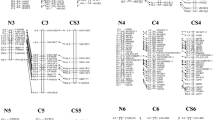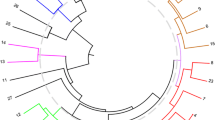Abstract
Southern hybridisation with a single microsatellite probe, (TCT)10, sufficed to discriminate between a representative set of cultivars/accessions of lettuce, Lactuca sativa L., and its wild relatives L. serriola, L. saligna and L. virosa. Variability within cultivars was tested in a relatively modern cultivar (Hector), where no variation was found, and in an older and morphologically more variable cultivar (Madrilene), where heterogeneity was observed in the TCT fingerprint. (TCT)10 fingerprinting should be useful for variety identification and homogeneity testing in lettuce.
Similar content being viewed by others
Author information
Authors and Affiliations
Additional information
Received: 25 July 1997 / Revision received: 5 August 1997 / Accepted: 30 August 1997
Rights and permissions
About this article
Cite this article
van de Wiel, C., Arens, P. & Vosman, B. Microsatellite fingerprinting in lettuce (Lactuca sativa L.) and wild relatives. Plant Cell Reports 17, 837–842 (1998). https://doi.org/10.1007/s002990050494
Issue Date:
DOI: https://doi.org/10.1007/s002990050494




